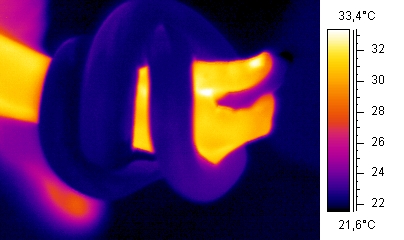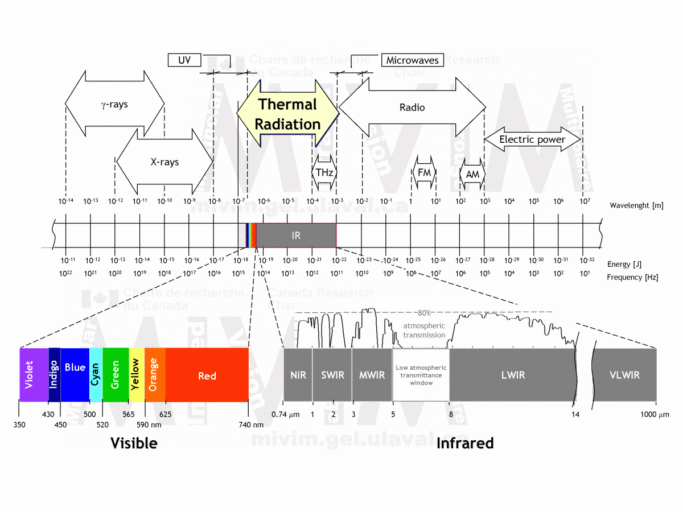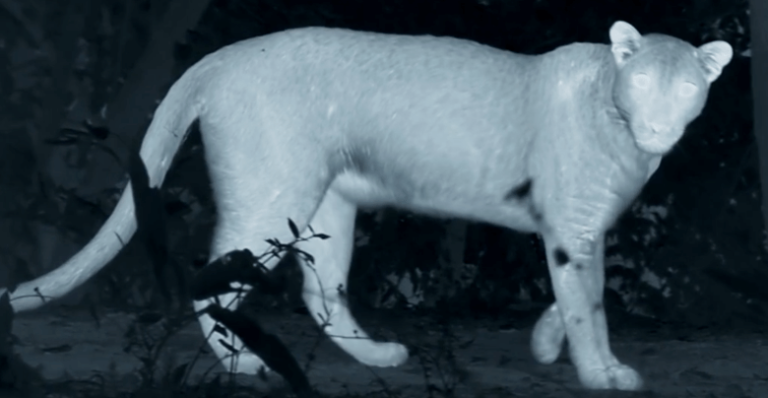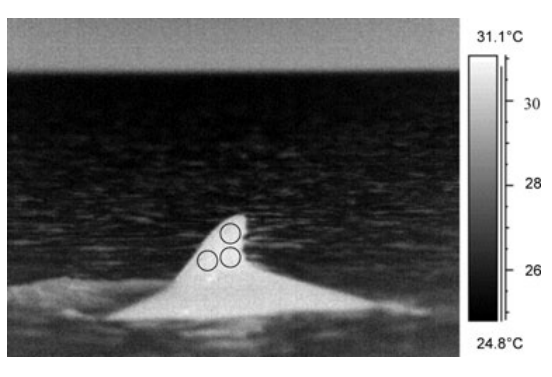- In this first of a new Wildtech series on “What is that technology?” we explore thermal imaging and its applications for wildlife.
- Thermography, or thermal imaging, detects infrared radiation to help see objects in the dark.
- Thermal cameras distinguish the relative temperature of objects around us to help us see warmer objects – like people and animals – against cooler backdrops, even at night.
- Thermal imaging has multiple applications for wildlife conservation, including helping with anti-poaching efforts, wildlife veterinary diagnoses, studying animal behavior, and nighttime filming for wildlife documentaries.
The novelty of seeing in the dark has captured our imagination for millennia, and people have employed fire, torches (flashlights), and, more recently, night vision goggles that amplify the tiniest traces of remaining light, to see in the dark. A relative newcomer in this search for night vision is the ‘thermal’ camera, but what exactly is a thermal camera? How does it work? And what are its applications for wildlife?
In the first of a series of articles on how things work, Mongabay-Wildtech answers some frequently asked questions (FAQs) about thermal imaging and its uses in wildlife management and conservation.
What is thermal imaging?
Thermal imaging, also known as infrared thermography, is a way to improve the visibility of objects in a dark environment. Thermal cameras detect heat given off by a person or other object and can capture the variation in temperature of objects around us. They create images of that radiation called thermograms, which display the relative temperatures of different objects with different shades or colors. In a thermogram, warm objects—such as people, animals, or cars—stand out in contrast to often cooler backgrounds. A thermal camera can’t “see” through a window because the window itself radiates some amount of heat, which is what the thermal sensor will detect.
This technology has been widely used to detect humans during military or surveillance operations at night. Additionally, firefighters and other search and rescue responders with thermal sensors can search for people trapped behind rubble or smoke. On a finer scale, thermal imaging is a safe and non-invasive method for sensing temperature distribution patterns on the surface of the body (Cilulko et al., 2013), making it an effective tool to monitor physiological changes in humans and warm-blooded animals.

How does it work?
Thermographic cameras (also known as thermal cameras) detect radiation in the long-wave infrared (IR) range of the electromagnetic spectrum (with wavelengths of 8– 14 micrometers). This contrasts with regular film and digital cameras that can detect light only in the portion of the electromagnetic spectrum that is visible to the human eye, known as the visible spectrum (0.40 – 0.75 micrometers).
Thermal cameras can visualize objects both with and without visible light, since all objects with a temperature above absolute zero (0 Kelvin = -459 ° Fahrenheit = -273 ° Celsius) emit infrared radiation. Most thermal cameras can only see objects warmer than -122 °F (-50 °C).

Are thermal imaging and night vision the same thing?
No. Thermal imaging and night vision share the common purpose of increasing visibility in low light conditions, but the science behind the technologies is different. Night vision works by collecting and amplifying all available light (which includes some short-wavelength infrared radiation), while thermal imaging captures longer wavelengths of IR. In addition to any remaining visible light, night vision uses near-infrared (NIR) radiation (0.75 – 1.40 micrometers), while most thermal imaging is based on long- wavelength (8–14 micrometers) infrared radiation. In order to detect long-wave IR, thermal imaging devices require more acute sensors, consequently making them more expensive than night vision devices.
While night vision technology improves visibility in low light conditions by magnifying the amount of light in the image, thermal imaging provides the added advantage of high contrast imagery, which makes it easier to identify a target against the background. The video below elaborates on this added capability and further explains the differences between night vision and thermal imaging.
Do thermal cameras only work at night?
No. Although thermal imaging cameras are most commonly used for nighttime vision, they can also be useful in daylight. The detection of heat radiation and the high contrast of thermal imaging cameras allow users to see the outlines of (warm-blooded) animals that camouflage well in their environments. It can also help distinguish animals (or people) in foggy or smoky conditions. This technology has proven helpful at reducing the negative impacts of agricultural operations on wildlife that inhabit crop fields, such as ground-nesting birds, hares, and fawns. In 2012, researchers at Denmark’s Aarhus University developed a tractor-mounted system that combines thermography and image processing software to automatically identify animals during mowing and other farming operations.
If it is used by the military, can it also be used to catch poachers?
Yes, there are many applications of thermal imaging for anti-poaching. The majority of poaching operations happen under the cover of night, as poachers use the darkness to avoid detection by wildlife officials and park rangers. Poaching of elephants and rhinos and the subsequent illicit trade in ivory and rhino horn has been linked to financing terror organizations: as poaching becomes highly militarized, conservationists and wildlife managers are looking to thermal imaging to improve their wildlife protection success. Last year, the Maasai Mara conservancies in Kenya used a host of thermal imaging devices to beef up anti-poaching efforts, which included mounting thermal cameras on ranger vehicles, and using handheld IR viewfinders. This approach has helped rangers detect and intercept poachers, but localized success does not erase the challenge of monitoring Africa’s expansive parks. Park managers are now pairing drones and thermal cameras to test the aerial scanning capability of drone-based thermal imaging systems to increase anti-poaching surveillance capacity [see Mongabay-Wildtech’s article on drones for anti-poaching.
How else is it used in relation to wildlife?
Thermal imaging has multiple applications in ecology and zoology, including but not limited to, detecting animals in the field, studying animal behavior and thermoregulation, diagnosing diseases, and monitoring reproductive processes. The technology has also been used for nighttime filming for wildlife documentaries.
Wildlife documentaries
Thermal cameras are commonly used to film nocturnal activity for wildlife documentaries. These technologies have enabled filmmakers to capture rare or never-before-seen footage of animal behavior, including a leopard hunting in urban Mumbai and the first nocturnal footage of leopards mating in Sri Lanka. Even in daylight, the thermal cameras also helped these film crews spot leopards and other small mammals that were well camouflaged behind shrub vegetation.

Veterinary medicine
Wildlife veterinarians have increasingly used thermal imaging in detecting changes in an animal’s physiological state by mapping its skin surface temperature in response to changes in blood flow. This has allowed clinicians to detect panda pregnancies, discover muscle problems, and diagnose conditions ranging from rabies in raccoons to arthritis in elephants.
Animal behavior studies
Animal behavior researchers use thermal imaging to study thermoregulation (regulation of body temperatures) in warm-blooded animals. It has helped researchers discover that Asian elephants cool down mainly through their trunks, rather than their ears, and that honey bees group together to form a hot defensive ball to kill predatory hornets. Thermal imaging has also been used to understand thermoregulation and animal behavior in cetaceans, such as bottlenose dolphins.

Does it only work on land? Can thermal imaging see at sea?
Researchers have recently started testing the use of thermal imaging for studying marine life. While we are unaware of any uses of thermal cameras underwater, they have been used to identify marine mammals from research vessels, and the technology could help study the surface behavior of whales, dolphins, and seals. Researchers recently tested the ability of thermal imaging to automatically detect cetaceans, combining a ship-mounted thermal camera with a detection algorithm to detect the thermal signature of whale blows. The number of whale observations sensed by thermal imaging was comparable to those identified by human marine mammal observers during the day. More importantly, the thermal camera can detect marine mammals at night, which people cannot. This technology could help reduce ship strikes on whales and inform vessels when to shut down their loud airguns, sonars, and other devices, to mitigate negative impacts of these noises on marine mammals.
Do you have any other questions about thermal imaging and its applications for wildlife conservation? Please let us know in the comments below!

